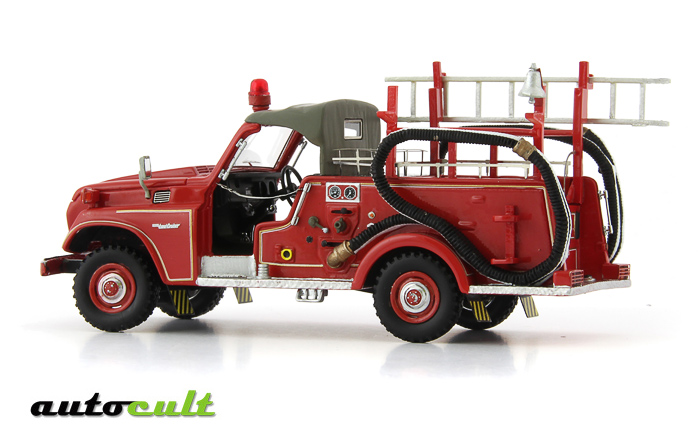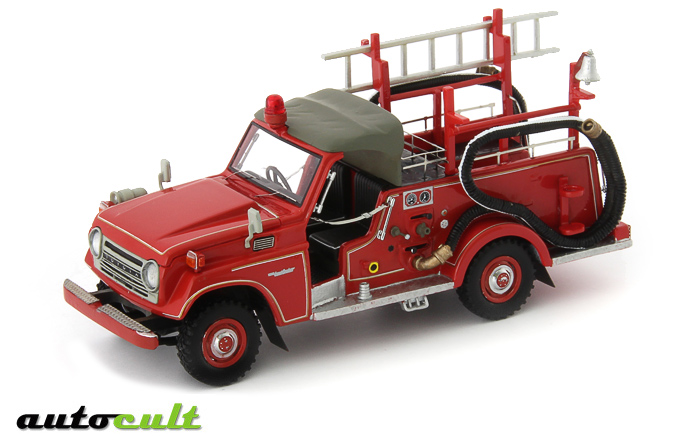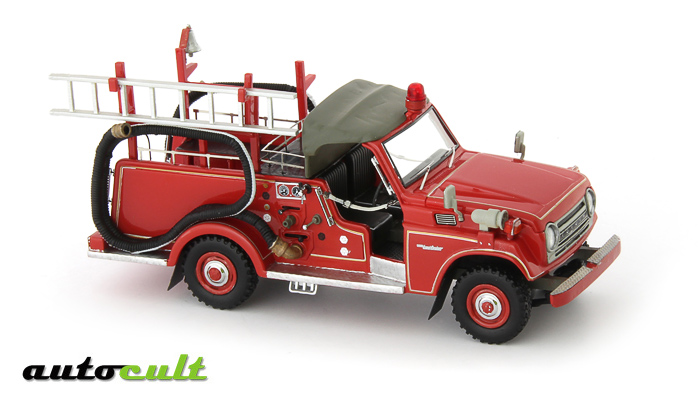| |
 Toyota Land Cruiser FJ56 - Feuerwehr
Toyota Land Cruiser FJ56 - Feuerwehr
Asiatische
Eigenheit
Mit
der japanischen Eigenart der türlosen Feuerwehrautos entstanden
auch Modelle auf Basis des Toyota Land Cruiser, für die Toyota
zwischen 1975 und 1980 den speziellen, nur in Japan erhältlichen
Typ 56 fertigte.
Als
Antrieb kam ein 4,2 Liter großer 6-Zylindermotor zum Einbau.
Nach den individuellen Ansprüchen der Feuerwehr wurde der
Aufbau gestaltet, bei dem sich die japanischen Karosseriebauer
sehr kreativ zeigten.
In erster Linie war es vor allem der Verzicht auf die beiden Türen,
die den Nippon-Geländewagen an die Wurzeln der gesamten Jeep-Generation
erinnerte. Bei den Feuerwehrausführungen lag dabei der gleiche
Gedanke zu Grunde, der auch schon bei der Entwicklung des ursprünglichen
Jeep´s vorhanden war. Es ging in beiden Fällen um ein
schnelles Ein- und Aussteigen. Das rasche Einsteigen sparte kostbare
Sekunden in der Feuerwache, wenn die Alarmsignale schrillten und
das Herausspringen am Brandherd sparte ebenfalls wertvolle Zeit.
Die Sitzmöglichkeiten von Fahrer und Beifahrer auf der fest
montierten Sitzbank waren sehr spartanisch. Genauso unkomfortabel
war auch die Sitzbank für die Kollegen, die am Heckaufbau
Platz nahmen. Der mangelnde Komfort wurde aber dann auch noch
deutlich, dass den Feuerwehrleuten nur ein knappes Stofftuch als
Dach diente, was das Fahren insgesamt sehr zugig machte. Für
die kalten Jahreszeiten gab es auch anknüpfbare Stofftüren,
doch ein wirklich wirksames Mittel gegen Kälte, Wind und
Regen dürfte auch dies nicht gewesen sein.
Den Feuerwehr-Toyota gab es je nach Modellbauweise und Achsstand
mit doppelter Sitzbank vorne oder ohne mittige Sitzgelegenheit
am Aufbau.
Eingesetzt
wurden solche speziellen Feuerwehr-Cruiser beispielsweise in der
japanischen Präfektur Fukui oder in Colombo, der Hauptstadt
Sri Lankas.
Aus Kapazitätsgründen führte der Land-Cruiser lediglich
die allerwichtigsten Feuerwehrutensilien an Bord mit, natürlich
in erster Linie einen mächtigen Feuerwehrschlauch, für
den ein externes Löschwasserreservoir benötigt wurde.
 Toyota Land Cruiser FJ56 - Fire Department
Toyota Land Cruiser FJ56 - Fire Department
Asian
Peculiarity
With the Japanese peculiarity of the doorless fire departments,
models were created based on a Toyota Land Cruiser, for which
Toyota was especially producing the type 56 only in Japan between
1975 and 1980.
A 4,2 liters 6-cylinder engine was installed for the drive, and
after the individual requirements of the fire department, the
construction was designed and the Japanese coach builders were
showing their creative way.
Primarily it was especially the waiver of both doors, which reminded
the Nippon off-road vehicle on the roots of the entire generation
of Jeep. It was always the same idea, which already existed during
the development of the original Jeep. In both cases, it was to
get on and off very fast. The quick get on was saving precious
seconds in the fire station when the alarm signals shrilled, and
the jump out upon arrival at the fire was also saving valuable
time.
The seat possibilities of the driver and co-driver were very spartan
on the firmly mounted bench seat. Also the bench seat for the
colleagues was uncomfortable, who took place on the rear end.
The lack of real comfort became clear, as only a short fabric
was used as a roof, which makes the driving very draughty in total.
For the cold season, there were also flick-up fabric doors, which
were not an effective means against cold, wind and rain.
The
fire department of Toyota was available, depending on the model
type and wheelbase, with a double bench at the front or without
a central seat on the superstructure.
Such special fire department Land-Cruisers were used for example
in the Japanese prefecture Fukui or in Colombo, the capital of
Sir Lanka.
For reasons of capacity, the Land Cruiser was carrying only all
most important firefighting equipment on board, of course primarily
a powerful fire horse, for which an external water reservoir was
needed.
|
|
 |
 Toyota Land Cruiser FJ56 - Vigili Del Fuoco
Toyota Land Cruiser FJ56 - Vigili Del Fuoco
Peculiarità
Asiatica
La peculiarità giapponese dei mezzi dei vigili del fuoco
senza portiere, era presente anche nei modelli basati sulla base
del Toyota Land Cruiser FJ56, venduta solo in Giappone tra il 1975
ed il 1980.
Un 4,2 litri 6 cilindri è stato installato come propulsore,
e dopo le esigenze individuali dei vigili del fuoco, la costruzione
è stata progettata da carrozzieri Giapponesi che hanno mostrato
alcune idee molto creative. In primo luogo è stata soprattutto
la rinuncia a due porte, che ricorda le radici creative del fuoristrada
Giapponese derivate dalla prima Generazione della Jeep Willys del
1949, In entrambi i casi, è utile ai passeggeri per salire
e scendere in maniera molto veloce. La cosa è molto utile
per le emergenze che i vigili del fuoco dovevano affrontare, guadagnando
minuti preziosi quando strillava l'allarme e bisognava recarsi sul
luogo dell'incendio. La tipologia dei sedili del conducente e del
co-pilota erano realizzati in maniera molto spartana ed anche i
sedili per i passeggieri erano molto disagevoli, la mancanza di
confort si faceva sentire e anche per il tetto c'erano delle problematiche
per il punto di vista delle condizioni atmosferiche, dato che era
realizzato in tessuto e durante l'inverno quest'ultimo materiale
veniva usato anche per realizzare delle portiere rudimentali che
purtroppo non erano un mezzo efficace per contrastare la pioggia
ed il freddo che i pompieri dovevano sopportare.
Il mezzo di trasporto Toyota del dipartimento dei vigili di fuoco
era disponibile, a seconda del tipo di modello e passo, con un doppio
banco nella parte anteriore o senza una sovrastruttura centrale.
Tali versioni speciali della Land Cruiser dei vigili del fuoco sono
stati utilizzati ad esempio nella prefettura giapponese di Fukui
o a Colombo, la capitale dello Sri Lanka. Per motivi di capacità,
il Land Cruiser trasportava solo tutti i più importanti impianti
antincendio a bordo, ovviamente in primo luogo un potente pompa
anti incendio,per la quale era necessario un serbatoio d'acqua esterna.
|
 |




